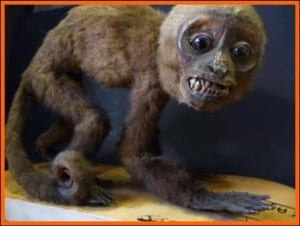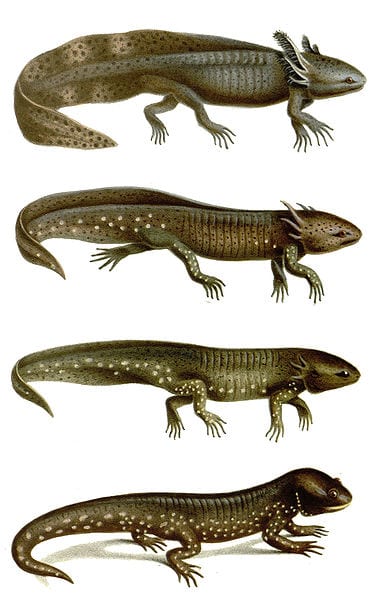Specimen of the Week: Week Seventy-Three
By Emma-Louise Nicholls, on 4 March 2013
 After all the excitement last week of the celebrity Jar of moles, this week I thought we’d look at a lesser known species that quite frankly, blows my zoologist mind. It lives like a fairy tale character but looks like an extra from Alien. This week’s Specimen of the Week is…
After all the excitement last week of the celebrity Jar of moles, this week I thought we’d look at a lesser known species that quite frankly, blows my zoologist mind. It lives like a fairy tale character but looks like an extra from Alien. This week’s Specimen of the Week is…
**The Axolotl**

The preserved axolotl (Xenopus laevis)
at the Grant Museum of Zoology. LDUCZ-W202
1) Axolotls are a seriously strange bunch of individuals. Axolotls are technically a species of the much more familiar looking, and sounding, salamander but they are the very embodiment of the Peter Pan fairytale, as these creatures literally never grow up. I don’t mean they spend their senior years reading Ben 10 and nodding along to Justin Bieber in their rocking chairs and slippers, I mean biologically, physiologically, even morphologically, they remain juveniles all their lives. This phenomenon is called neoteny and requires them to become sexually mature in their ‘infant’ form, because they never undergo complete metamorphosis. Like a race of tadpoles that live and breed as tadpoles, and never turn into frogs. Weeeee-uuurrd.
2) Axolotls have a tiny range. Like something out of a Sci-Fi novel, they inhabit the ancient system of water channels and lakes within Mexico City. They require deep-water and an abundance of aquatic vegetation as they lay their eggs in foliage within the water. Unlike more usual salamander species, the axolotl lives its whole life in water. They are nocturnal, coming out at night to feed on invertebrates. The most notable aspects of an axolotl are the three pairs of branching gills that literally radiate out from the head.

Captive pink axolotl. (Image taken by Henry Mühlpfordt.
Image taken from commons.wikimedia.org)
3) Now here’s a clever party trick. If an axolotl loses a limb, as it may do if it say, tries to escape from the jaws of a predator (most often a heron, or other water bird), it can regenerate the lost appendage. Wish I could do that to my bank balance. Rather than scar tissue forming around the wound, the tissues in the damaged area convert to a stem cell-like state. This means that they can re-grow the missing tissue to regenerate a limb, a tail, and apparently even heart and brain cells. Wowsers.

The metamorphosis of the axolotl. (Illustrations by
Josèphe Huët. Taken from commons.wikimedia.org)
4) Now it is possible for an axolotl to metamorphose into an adult salamander, but it normally requires the introduction of hormones. It is thought that the larval state is maintained due to a lack of iodine in the natural environment and sure enough, if you give some to a captive individual, it will transform. In the wild, an axolotl may metamorphose into an adult Mexican salamander if its habitat dries up. Unlike the Mumm-Ra the ever-living however, it can’t go back. A normal infant-looking-but-adult-aged axolotl, that has quite literally retained its baby-face, will live for around 10 years. Wild axolotls are normally black. However, humans, as humans tend to do, have interfered and made them into pets, which of course requires them to now come in various colours and sizes to suit everybody’s tastes. Therefore, you can purchase an axolotl in black, grey, brown, pink or white. However, any conservationist worth his or her salt would of course advise you not to given that the pet trade is responsible for decimating… oh so many species. Axolotls, which are now critically endangered, are on this list. Their main worry right now however, is actually pollution of their habitat as it turns out they breed quite well in captivity. All individuals of the white captive form, as an interesting side note, are all thought to be descended from one mutant individual brought to Paris in 1863.
5) The name axolotl comes from the Aztec language of Nahuatl, in which the words for ‘water’ and ‘dog’ go together to form axolotl. The axolotl is also associated with the Aztec God of Death ‘Xolotl’ who assumed the form of an amphibian in an effort to escape but was killed while still in an amphibian form. Oooh dear.
Emma-Louise Nicholls is the Museum Assistant at the Grant Museum of Zoology
One Response to “Specimen of the Week: Week Seventy-Three”
- 1
 Close
Close


[…] scarring. If you want to find out more about the extraordinary features of the axolotl, read this post from the Grant Museums’ Specimen of the Week […]